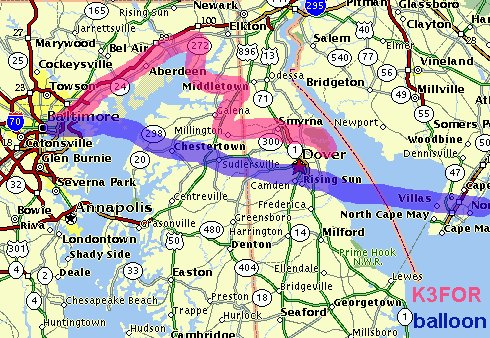launch test balloon
Midshipman 2/c Russ Meier KB3EKM MARS Call NNN0BRLT and
Ryan (Skip) Johnson LT, USNR K3FOR MARS Call NNN0PEK
from Naval Academy Amateur Radio Station W3ADO, and
Bob Bruninga WB4APR, CDR, USN (ret.) and
Midshipman 1/c Sean Olone
from USNA's Satellite Lab in Rickover Hall,
Department of Engineering and Weapons
Launched and tracked a 10-milliwatt 1-oz $25 balloon payload (PROGRAM INFO HERE) on Sunday, 26 March 2000 from the B.R.A.C. Timonium Hamfest in Baltimore. The balloon was tracked for 4 hours and exceeded expectations by traversing the Chesapeake Bay, Delaware River, and New Jersey, before being lost out into the Atlantic Ocean, still going strong, at over 30,000 feet.
In Bob's words...
The good news:
We proved that the $8 10mw key chain transmitters on 433 MHz can be
tracked over many 10's of miles suitable for balloons. We proved that
a single 18" party balloon can cary such a payload (30g), and that a total
low cost mission could be done as follows:
Key Chain transmitter $8 (ours was $24 before we heard of the Tandy ones)
555 Oscillator and thermister $2
Lithium Battery 2 @ $4.25 $9 (this would give >24 hours)
18" rubber party balloon $2
10% of a 14 cuft Helium bottle $3
Total $24
The Bad news: We underinflated the first 2 balloons and had to use a
third just to get it up, whereas a single fully inflated 18" balloon would
have done it. Remember, this was a TEST launch to learn lessons before
our real launch next week. We learned em!
The Good news: It flew and provided plenty of chase entertainment.
The Bad news: ...
Then the balloon headed more north, instead of the ALWAYS winds going SE
so we all (3 vehicles) decided to head up I-95 and take the 120 mile
northern route around the Chesapeak bay, instead of the 100 mile southern
route over the bridge. ...
Being quite spread out, it probably took about 15 minutes to find everyone
there and then we were all starting to finally get good bearings amd most
APRS was starting to work. Then the repeater [went down for maintenance.]
We never recovered. None of the mobiles ever found each other and the
rest of the day was spent in isolation, all heading east. After clearing
the Chesapeake bay, it was soon apparent that the balloon was also going
to go over the Deleware bay and into New Jersey. That would have been
another 120 mile end-around, and by now the Balloon was 100 miles away and
moving at 70 MPH... across Cape May and out to sea.
...
Bob
Here's the path of the balloon and the chase vehicle of Skip Johnson K3FOR

Attaching small 1oz payload to the "lifters"
Yes, it is 1 oz
A party balloon and streamer
The handheld Arrow dual-band Antenna (only half-boom shown, 2 meter elements removed) makes for good mobile DF
Bob WB4APR inflating the balloons with helium
Bob WB4APR getting assistance stringing the balloons
The carrier frequency was varied somewhat due to temperature
and the audio tone provided the temperature telemetry
Midshipman Russ Meier KB3EKM left and Skip K3FOR right in the chase
Russ KB3EKM is DF'ing the balloon with a Kenwood TH-D7 on 440Mhz with an Arrow Beam
from Interstate 95 north of Baltimore
(at this point the balloon was determined to be at 10,000 feet, rising at 500/minute, and was 3 miles away,
headed southeast from Timonium toward the Bay
On K3FOR's truck from left to right are: 80-meter Hustler resonator, 10-meter whip on manual tuner,
2 meter APRS antenna (further right are Garmin GPS antenna and 2m/440 voice antenna)
Russ KB3EKM navigates and operates APRSdos from a Zenith 386 laptop, Garmin 12XL, and Kenwood TH-D7 (with 30 watt amp) [mobile HF tuner and MFJ 1270 TNC below laptop not used for this event]
Point of Contact :
LT Skip Johnson/K3FOR/NNN0PEK, Club Advisor
Revision Date :
URL : http://www.qsl.net/w3ado/

